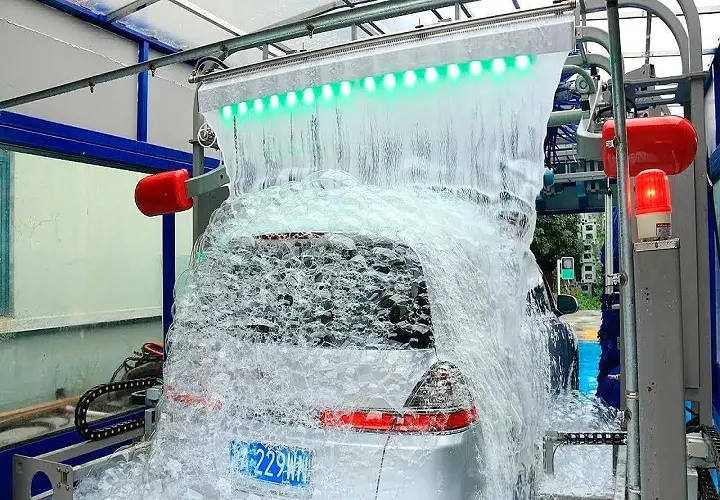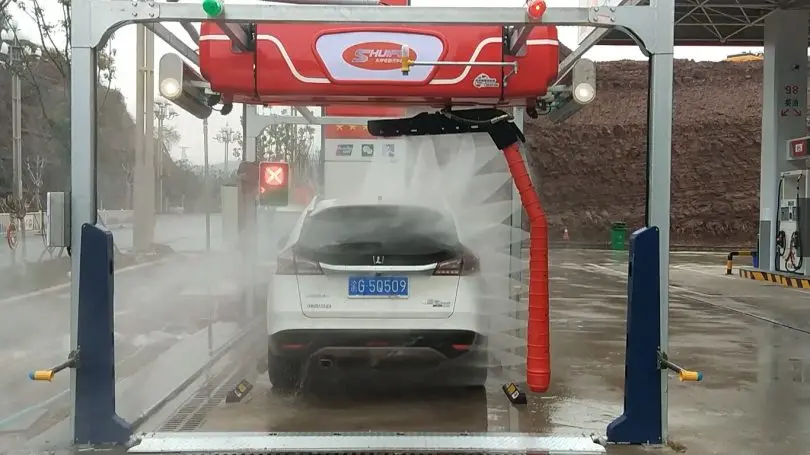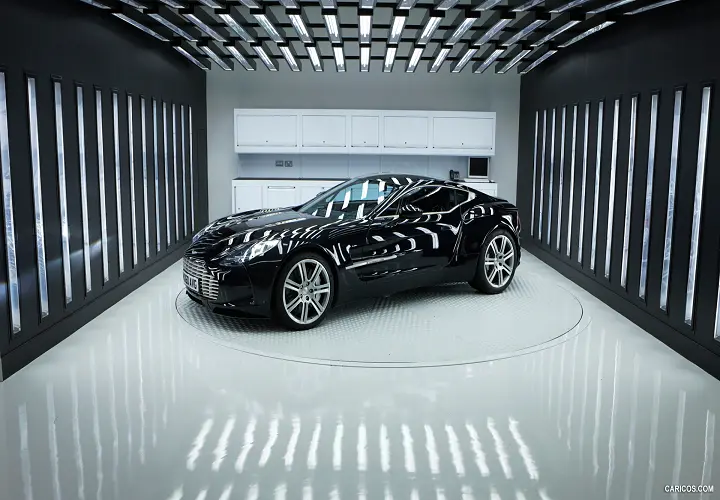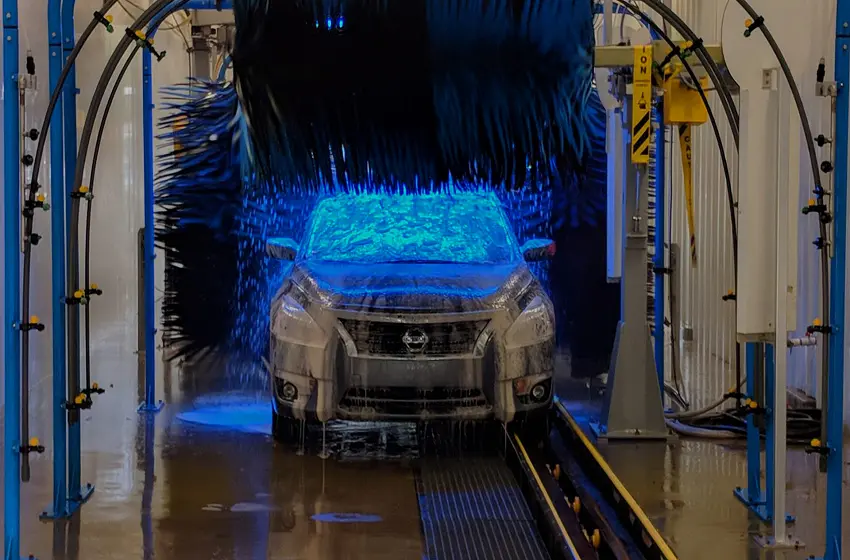In a world where time is money and convenience is king, the automatic car wash has become a modern marvel for vehicle owners everywhere.
Gone are the days of spending your Saturday afternoon armed with a bucket, sponge and garden hose. Today, we’re diving deep into the world of automated cleaning, exploring everything from the nuts and bolts of how these machines work to the future of car cleanliness. Buckle up, because we’re about to take a spin through the sudsy universe of automatic car washes!
The Evolution of Car Cleaning: From Elbow Grease to Automation
Remember when washing your car meant a workout? You’d spend hours scrubbing, rinsing, and buffing until your ride gleamed. But in 1940, everything changed. The first automatic car wash rolled onto the scene in Hollywood, California, revolutionizing vehicle maintenance forever.
At first, these early automatic washes were more “semi-automatic.” Workers would push cars through a tunnel while automated brushes and sprayers did the heavy lifting. Fast forward to today, and we’ve got fully automated systems that can clean a car in minutes without a human hand in sight.
“The automatic car wash industry has come a long way since its inception. What started as a labor-saving idea has transformed into a technological marvel that saves time, water, and energy.” – John Smith, Automotive Historian
This evolution hasn’t just made life easier for car owners. It’s created an entire industry, with the U.S. car wash market valued at $14.21 billion in 2022 and expected to grow to $20.74 billion by 2028, according to a report by Grand View Research.
The journey from manual washing to automation has been marked by several key milestones:
- 1940s: The first automatic car wash opens in Hollywood, California
- 1950s: Conveyor belt systems are introduced, increasing efficiency
- 1960s: Soft cloth materials replace abrasive brushes, reducing the risk of paint damage
- 1970s: Computer-controlled systems begin to appear, improving consistency
- 1980s-1990s: Water reclamation systems become more common, addressing environmental concerns
- 2000s-Present: Integration of advanced sensors, touchless options, and eco-friendly cleaning solutions
Types of Automatic Car Washes: Choose Your Adventure
Not all automatic car washes are created equal. Let’s break down the main types you’ll encounter:
Tunnel Systems: The Conveyor Belt Experience
Picture this: you drive onto a conveyor belt, put your car in neutral, and let the machine do its thing. As you glide through the tunnel, a series of brushes, sprayers, and dryers work their magic. It’s like a spa day for your car!
Pros:
- High throughput (can clean many cars quickly)
- Comprehensive cleaning process
- Often the cheapest option per wash
Cons:
- Can be intimidating for first-timers
- Potential for damage if car isn’t properly aligned
Tunnel systems are the workhorses of the car wash world. They can process up to 100 cars per hour, making them ideal for busy locations. The typical tunnel is 50-100 feet long and equipped with various stages of cleaning:
- Pre-soak
- Wheel cleaning
- Main wash (with multiple brush and spray zones)
- Rinse
- Waxing (optional)
- Drying
In-Bay Automatics: The Solo Cleaning Dance
Drive in, park, and watch as a robotic arm dances around your vehicle, spraying, scrubbing, and drying. It’s like a private performance for your car.
Pros:
- No need to move your car during the wash
- Often found at gas stations for convenience
- Good for larger vehicles that might not fit in tunnels
Cons:
- Slower than tunnel systems
- May miss spots due to fixed washing patterns
In-bay automatics are perfect for locations with limited space or lower traffic. They typically take 5-10 minutes per wash, depending on the selected options. These systems use a combination of high-pressure sprays and rotating brushes or cloth strips mounted on a moving gantry.
Self-Serve Bays: For the DIY Enthusiast with a Twist
While not fully automatic, these bays offer a hybrid experience. You control the wand, but automated soap dispensers and pressure washers do the heavy lifting.
Pros:
- Control over the cleaning process
- Can focus on problem areas
- Often cheaper than full-service options
Cons:
- Requires more time and effort
- Effectiveness depends on user skill
Self-serve bays typically offer a range of options:
- Pre-soak
- High-pressure wash
- Foam brush
- Rinse
- Wax
- Spot-free rinse
Most self-serve bays operate on a timer system, with each option costing a certain amount of time. This allows users to customize their wash experience based on their needs and budget.
How Does an Automatic Car Wash Actually Work?

Ever wonder what’s happening behind those flapping brushes and curtains of water? Let’s pull back the curtain on the science of suds.
The Key Components
- Presoak Arch: Applies a chemical solution to loosen dirt and grime.
- Brushes or Soft Cloth Strips: Physical scrubbers that remove stubborn dirt.
- High-Pressure Water Jets: Blast away loosened debris.
- Soap Dispensers: Apply cleaning agents for a deep clean.
- Rinsing Arches: Remove soap and any remaining dirt.
- Waxing Station (optional): Applies a protective coat.
- Dryers: Powerful blowers that remove water droplets.
The Brains of the Operation
Modern automatic car washes are run by sophisticated computer systems. These systems control:
- Timing of each cleaning stage
- Amount of water and cleaning agents used
- Speed of the conveyor belt (in tunnel systems)
- Pressure of water jets
- Movement of brushes or cloth strips
Sensors play a crucial role, detecting the size and shape of each vehicle to adjust the cleaning process accordingly. Some advanced systems even use RFID technology to recognize repeat customers and apply their preferred wash settings!
The Chemistry Behind the Clean
Automatic car washes use a variety of specialized cleaning agents:
- Presoaks: Usually alkaline solutions that help break down dirt and oil
- Detergents: Surfactants that reduce water tension and lift dirt from the surface
- Foam Conditioners: Lubricating agents that help brushes glide smoothly over the car’s surface
- Spot-Free Rinse Agents: Chemicals that prevent water spots by altering the surface tension of water droplets
These chemicals are carefully formulated to be effective at cleaning while being gentle on car finishes and environmentally friendly.
The Pros of Automatic Car Washes: Why They’re a Driver’s Best Friend
- Time-Saving Magic: In and out faster than you can say “sparkle.” Most automatic washes take 3-5 minutes, compared to 30-60 minutes for a hand wash.
- Water Conservation: Surprisingly eco-friendly! Automatic car washes use about 35-50 gallons of water per car, while home washing can use up to 140 gallons.
- Consistency: Same clean, every time. No missed spots because you got distracted by your neighbor’s new landscaping.
- Cost-Effective: While prices vary, many automatic washes offer monthly subscriptions that can save frequent washers a bundle.
- Gentle on Paint: Modern soft-touch systems are designed to be kinder to your car’s finish than DIY methods.
- All-Weather Option: Rain or shine, you can get your car cleaned without braving the elements.
- Reduced Physical Strain: No more backaches from bending over to scrub your wheels!
- Professional-Grade Cleaning Products: Access to high-quality detergents and waxes that might be expensive or hard to find for home use.
- Undercarriage Cleaning: Many automatic washes offer undercarriage cleaning, which is difficult to do at home.
- Convenience: Often located in high-traffic areas or near gas stations for easy access.
Potential Drawbacks: Let’s Keep It Real
No system is perfect, and automatic car washes have their critics. Here are some potential downsides to consider:
- Paint Scratches: While rare with modern systems, it’s not impossible. Dirt trapped in brushes can potentially cause minor scratches.
- One-Size-Fits-All Approach: When your ride needs special attention, an automatic wash might not cut it.
- The Occasional Missed Spot: Nobody’s perfect, not even robots. You might find a patch of dirt here and there.
- Potential for Water Spots: If the dryers aren’t up to snuff, you might end up with water marks.
- Not Ideal for Classic Cars: Owners of vintage vehicles often prefer gentler hand-washing methods.
- Limited Customization: You can’t choose to spend extra time on particularly dirty areas.
- Possible Damage to Loose Parts: Antennas, loose trim, or aftermarket additions could be at risk if not properly secured.
- Chemical Exposure: While most modern car washes use eco-friendly products, repeated exposure to strong cleaning agents could potentially affect your car’s finish over time.
- Cost Over Time: While individual washes are often cheaper than a full hand wash, frequent use of automatic washes can add up.
- Psychological Factor: Some car enthusiasts simply prefer the satisfaction of washing their cars themselves.
Preparing Your Car for an Automatic Wash: Pro Tips
To get the most out of your automatic car wash experience, follow these tips:
- Retract Your Antenna: If it’s retractable, tuck it in to avoid damage.
- Secure Loose Parts: Make sure wipers, side mirrors, and any aftermarket additions are snug.
- Roll Up Windows: Seems obvious, but you’d be surprised how often people forget!
- Remove Roof Racks: If possible, take off any removable roof accessories.
- Know Your Vehicle: If you have a soft-top convertible or any delicate modifications, consider hand washing instead.
- Check for Existing Damage: Note any scratches or dents before entering the wash to avoid false claims.
- Remove Bugs and Bird Droppings: Pre-treat these stubborn spots to ensure they come off in the wash.
- Fold In Side Mirrors: If your mirrors fold, tuck them in to protect them.
- Remove Valuable Items: Take out any items that could be damaged by water seepage.
- Choose the Right Wash Package: Consider your car’s current condition and choose a package that addresses your needs.
Automatic vs. Hand Washing: The Great Debate
| Factor | Automatic Wash | Hand Wash |
| Time | 3-5 minutes | 30-60 minutes |
| Water Usage | 35-50 gallons | Up to 140 gallons |
| Cost | $5-$20 per wash | $10-$30 for supplies |
| Consistency | High | Varies |
| Personalization | Low | High |
| Environmental Impact | Lower water usage, controlled runoff | Higher water usage, potential chemical runoff |
| Physical Effort | Minimal | Significant |
| Quality Control | Machine-dependent | User-dependent |
| Frequency | Can be done more often due to convenience | Generally less frequent due to time investment |
| Attention to Detail | Limited | High (if done properly) |
While automatic washes win on efficiency and water conservation, hand washing allows for more attention to detail and personalization. The best choice often depends on your specific needs and circumstances.
Case Study: The Johnson Family’s Car Wash Experiment
The Johnson family decided to compare automatic and hand washing over a three-month period. They have two identical sedans and alternated washing methods each week. Here’s what they found:
- Time Spent: The automatic wash saved them an average of 45 minutes per week.
- Water Usage: Their home water bill decreased by about $10 per month when using the automatic wash.
- Car Appearance: Both cars looked clean, but the hand-washed car had a slightly better shine on close inspection.
- Convenience: The family reported being more likely to wash the car regularly when using the automatic option.
- Cost: The automatic washes cost slightly more over time, but the family felt the time saved was worth it.
Conclusion: The Johnsons decided to use the automatic wash for regular cleaning and do a thorough hand wash once a month for best results.
The Future of Automatic Car Washes: What’s on the Horizon?
The car wash industry isn’t resting on its laurels. Here are some exciting developments to watch for:
- AI and Machine Learning: Imagine a wash that remembers your car’s trouble spots and adjusts accordingly. AI could analyze each vehicle’s specific needs and customize the wash process in real-time.
- Waterless Systems: Using advanced polymers and nano-technology, these systems could revolutionize car cleaning in water-scarce regions. Some prototypes use less than a cup of water per wash!
- Integration with Self-Driving Cars: Picture your autonomous vehicle taking itself for a wash while you’re at work. This could be especially useful for ride-sharing fleets.
- Eco-Friendly Solutions: Biodegradable soaps and recycled water systems are becoming more common. Some car washes are even exploring solar power to run their operations.
- Mobile Wash Units: Bringing the automatic wash to your driveway or office parking lot. These units could be summoned via app, similar to ride-sharing services.
- Advanced Drying Technologies: New infrared drying systems promise to dry cars more quickly and thoroughly, reducing water spots and the need for hand drying.
- Augmented Reality Interfaces: AR could guide customers through the wash process, showing them what’s happening to their car in real-time and offering tips for better results.
- Subscription-Based Models: More car washes are likely to offer Netflix-style subscriptions, allowing unlimited washes for a monthly fee.
- Integration with Smart Cities: Car washes could become part of smart city infrastructure, with city-wide systems for keeping autonomous and shared vehicles clean.
- Nano-Coating Application: Some futuristic car washes might apply protective nano-coatings that repel dirt and water, keeping cars cleaner for longer periods.
Choosing the Right Automatic Car Wash: A Buyer’s Guide

Not all car washes are created equal. Here’s what to look for:
- Equipment Quality: Well-maintained machines with soft-touch materials are key. Look for car washes that regularly update their equipment.
- Water Quality: Look for washes that use filtered or softened water to prevent spotting. Some high-end washes even use reverse osmosis systems for spot-free rinses.
- Chemical Usage: Eco-friendly, pH-balanced soaps are best for your car and the environment. Ask about the products used and whether they’re biodegradable.
- Drying System: Powerful air dryers reduce the need for hand drying and minimize water spots. Some washes offer heated drying for better results.
- Customer Reviews: Check online ratings and ask local car enthusiasts for recommendations. Look for consistently positive feedback over time.
- Wash Options: A good car wash should offer a range of options to suit different needs and budgets. Basic washes, premium packages, and a la carte services provide flexibility.
- Staff Professionalism: Even in a largely automated process, staff attitude and helpfulness can make a big difference in your experience.
- Location and Accessibility: Consider convenience factors like proximity to your regular routes and ease of entry/exit.
- Operating Hours: 24/7 operations can be a big plus for busy schedules or unexpected cleaning needs.
- Additional Services: Some car washes offer extras like vacuuming stations, detailing services, or even coffee shops to enhance the customer experience.
Membership Programs: Are They Worth It?
Many car washes offer monthly subscription plans. These can be a great deal if you:
- Wash your car at least once a week
- Live in an area with frequent bad weather or environmental factors (like pollen) that dirty your car quickly
- Value the convenience of unlimited washes
Typical membership benefits include:
- Unlimited washes (usually of a specific package level)
- Discounts on upgraded wash packages or additional services
- Faster service through dedicated member lanes
- Special promotions or member-only events
When considering a membership, do the math:
- Calculate how often you typically wash your car
- Compare the cost of individual washes to the monthly membership fee
- Factor in the value of convenience and any additional perks
For example, if a basic wash costs $10 and you typically wash your car weekly, that’s $40-$50 per month. If a monthly unlimited wash membership costs $30, you’re saving money and might even wash more frequently.
DIY Maintenance Between Washes: Keeping the Shine Alive
To extend the life of your automatic car wash and keep your ride looking its best:
- Quick Detailing Spray: Use between washes to remove light dust and fingerprints.
- Microfiber Cloths: Keep a few in your trunk for spot cleaning.
- Windshield Treatment: Apply a water-repellent coating to improve visibility in rain.
- Regular Waxing: Every 3-4 months can help protect your paint and make cleaning easier.
How Often Should You Wash?
- Weekly: If you live in an area with harsh weather or environmental conditions
- Bi-weekly: For average use in mild climates
- Monthly: Minimum for maintaining your car’s finish
The Business of Bubbles: Running an Automatic Car Wash
For the entrepreneurs out there, the car wash business can be lucrative but challenging. Here’s a quick overview:
Initial Investment: $2-3 million for a modern, multi-bay facility Ongoing Costs:
- Water and electricity
- Cleaning solutions and materials
- Equipment maintenance
- Staff (if not fully automated)
Marketing Strategies That Make a Splash:
- Local SEO to capture “car wash near me” searches
- Loyalty programs and mobile apps
- Partnerships with local businesses (e.g., “free wash with oil change”)
- Seasonal promotions (pollen season specials, winter salt removal packages)
Automatic Car Washes Around the World: A Global Perspective

Car washing habits vary widely across cultures. Here are some interesting global twists:
- Japan: Known for their high-tech everything, Japan boasts car washes with fine-mist systems that use minimal water.
- Germany: Home to some of the world’s longest car wash tunnels, some stretching over 200 feet!
- Dubai: Offers luxury car washes with hand detailing for high-end vehicles, blending automation with a personal touch.
- Australia: Pioneering waterless wash systems to combat drought conditions.
The World’s Most Unique Car Wash: The Cadillac Ranch in Amarillo, Texas isn’t a car wash, but it’s worth mentioning. This public art installation features a row of half-buried, graffiti-covered Cadillacs. While you can’t clean your car there, it’s a testament to America’s love affair with automobiles and their care.
Conclusion: The Clean Future of Automated Car Care
As we’ve seen, the humble automatic car wash has come a long way from its Hollywood beginnings. Today, it stands at the intersection of convenience, technology and environmental responsibility. Whether you’re a weekly washer or a special-occasion cleaner, understanding the ins and outs of these sudsy systems can help you keep your ride looking its best with minimal fuss.
Remember, while automatic car washes offer unbeatable convenience, they’re just one tool in your car care arsenal. Combining regular automatic washes with occasional detailing and consistent at-home maintenance will keep your vehicle looking showroom-fresh for years to come.
So the next time you’re faced with a dirty car and a busy schedule, don’t sweat it. Just roll into your local automatic car wash, sit back, and watch the magic happen. Your car (and your calendar) will thank you!

With over 5 years of dedicated experience in the automotive industry, I am passionate about all things automotive. My journey began with a deep curiosity for automobiles, which led me to delve deeper into their mechanics, technology and trends. My expertise spans various aspects of the automotive world, from the latest electric vehicles to classic car restoration techniques. Through my articles, I aim to share my knowledge and insights, helping readers stay informed and inspired in the fast-paced world of the automobile.











